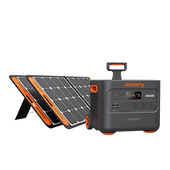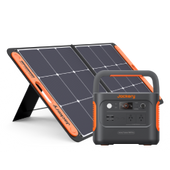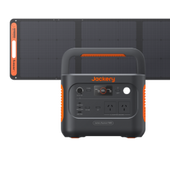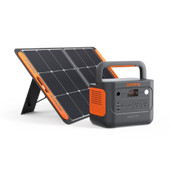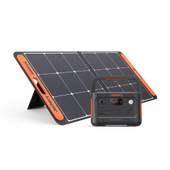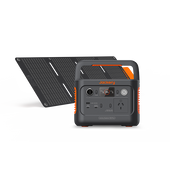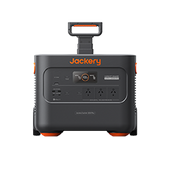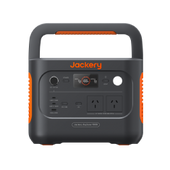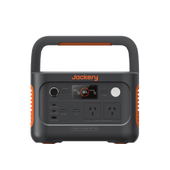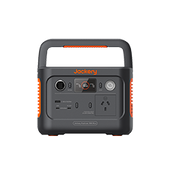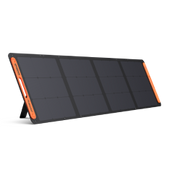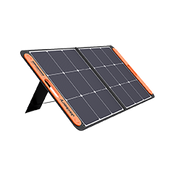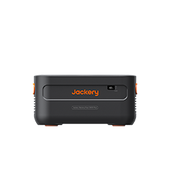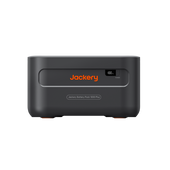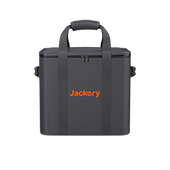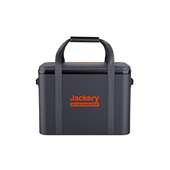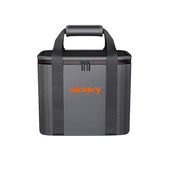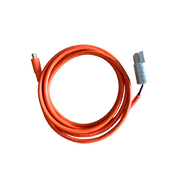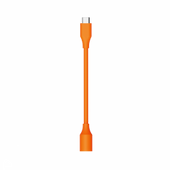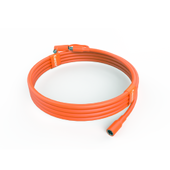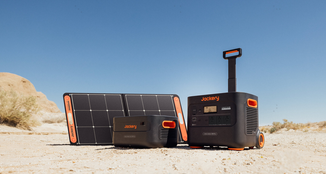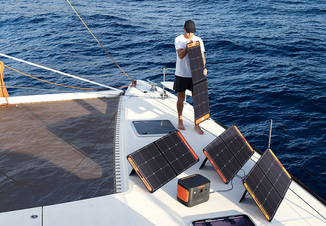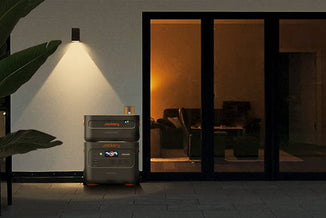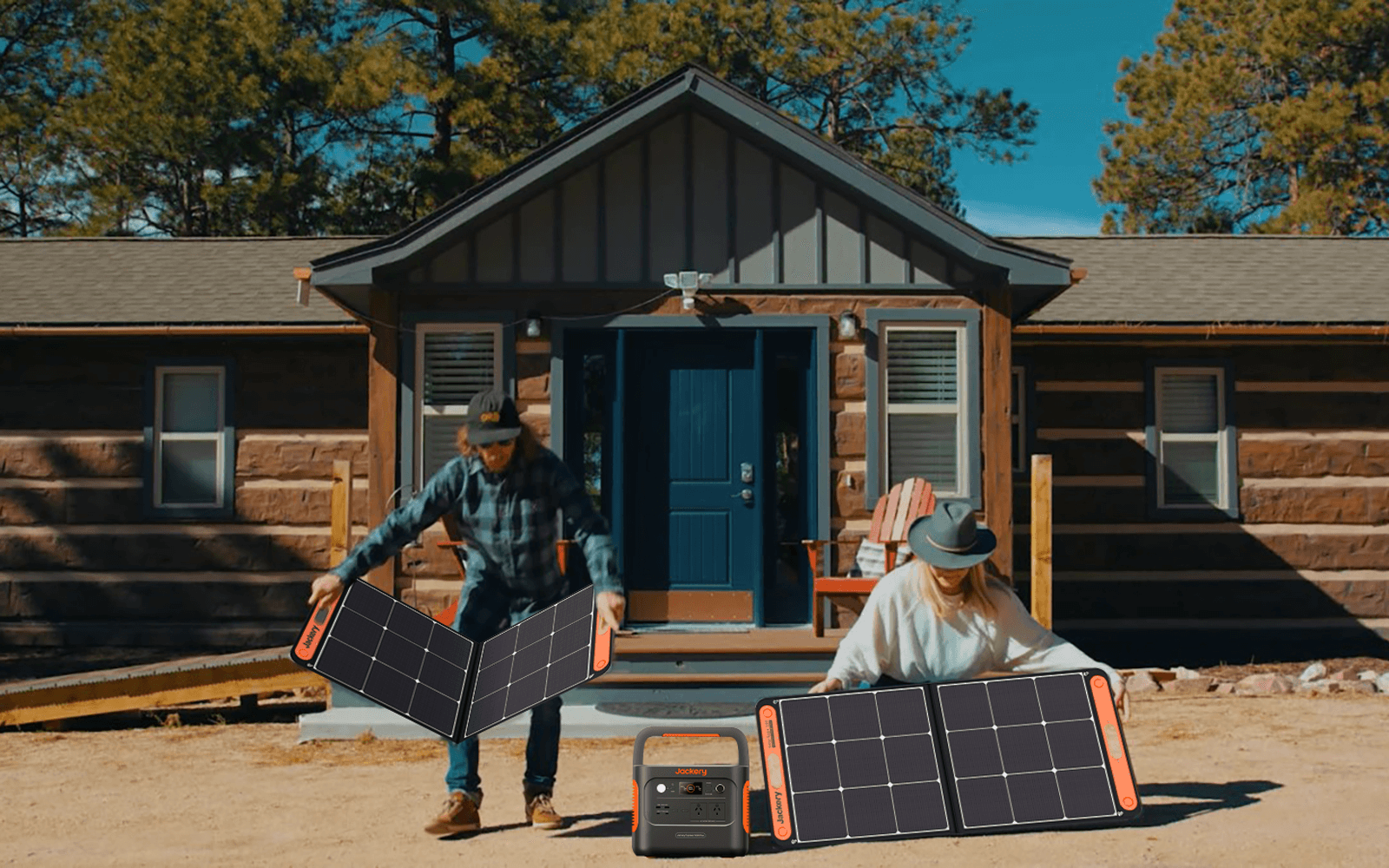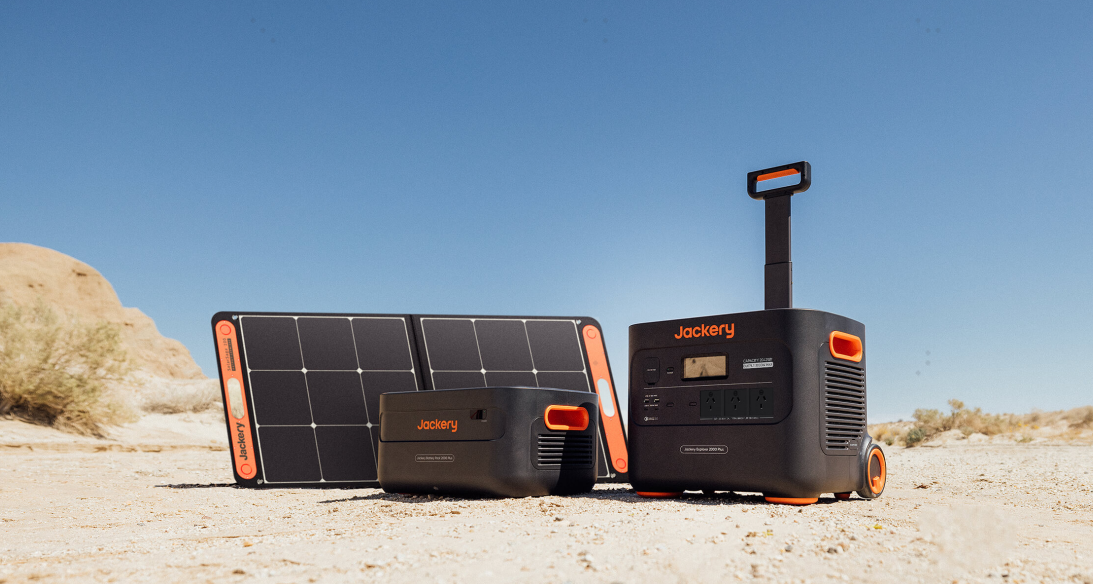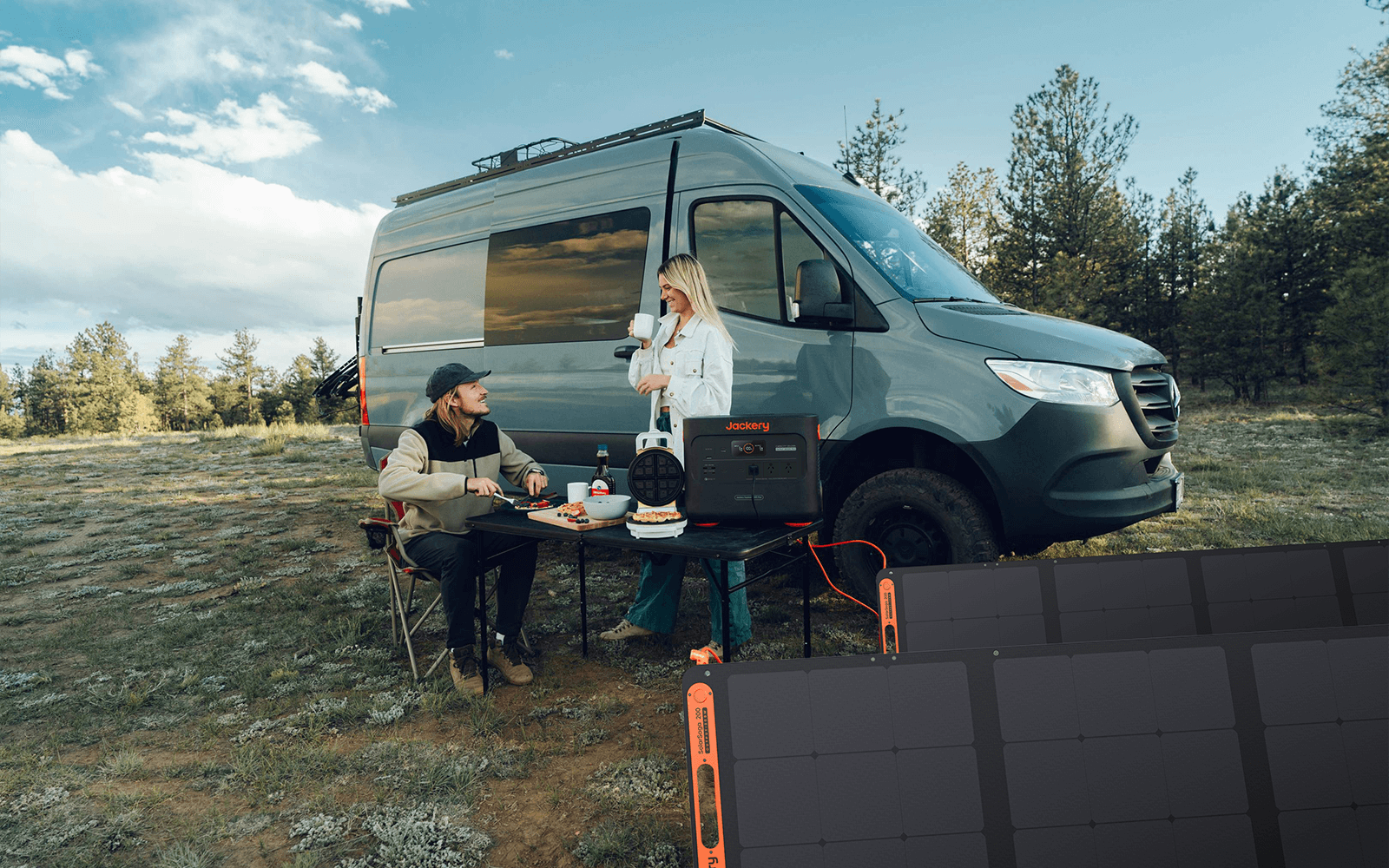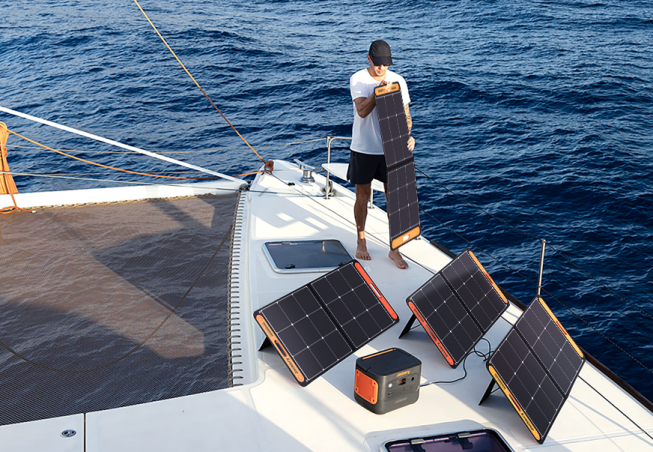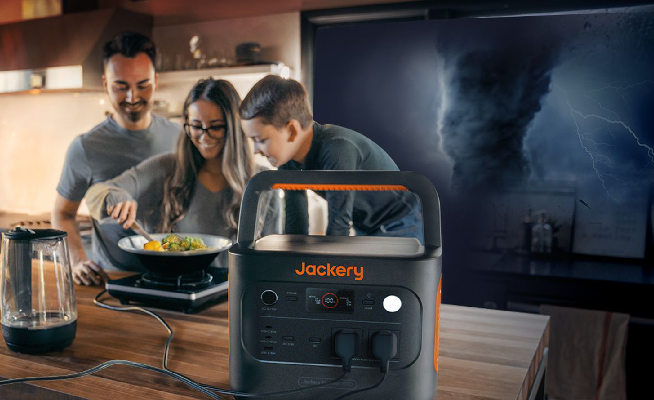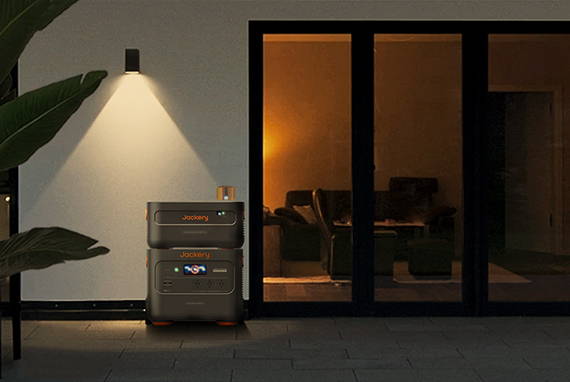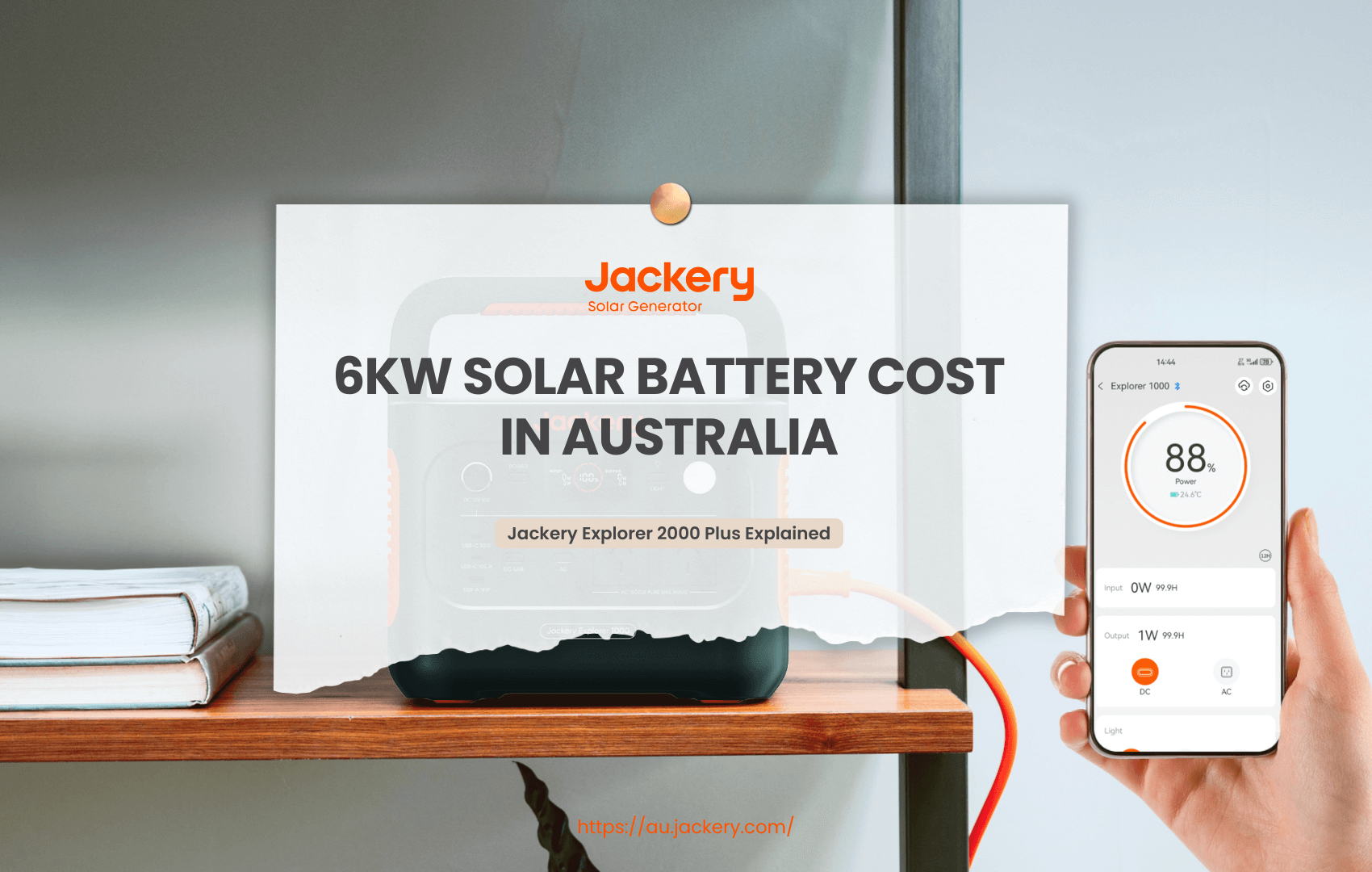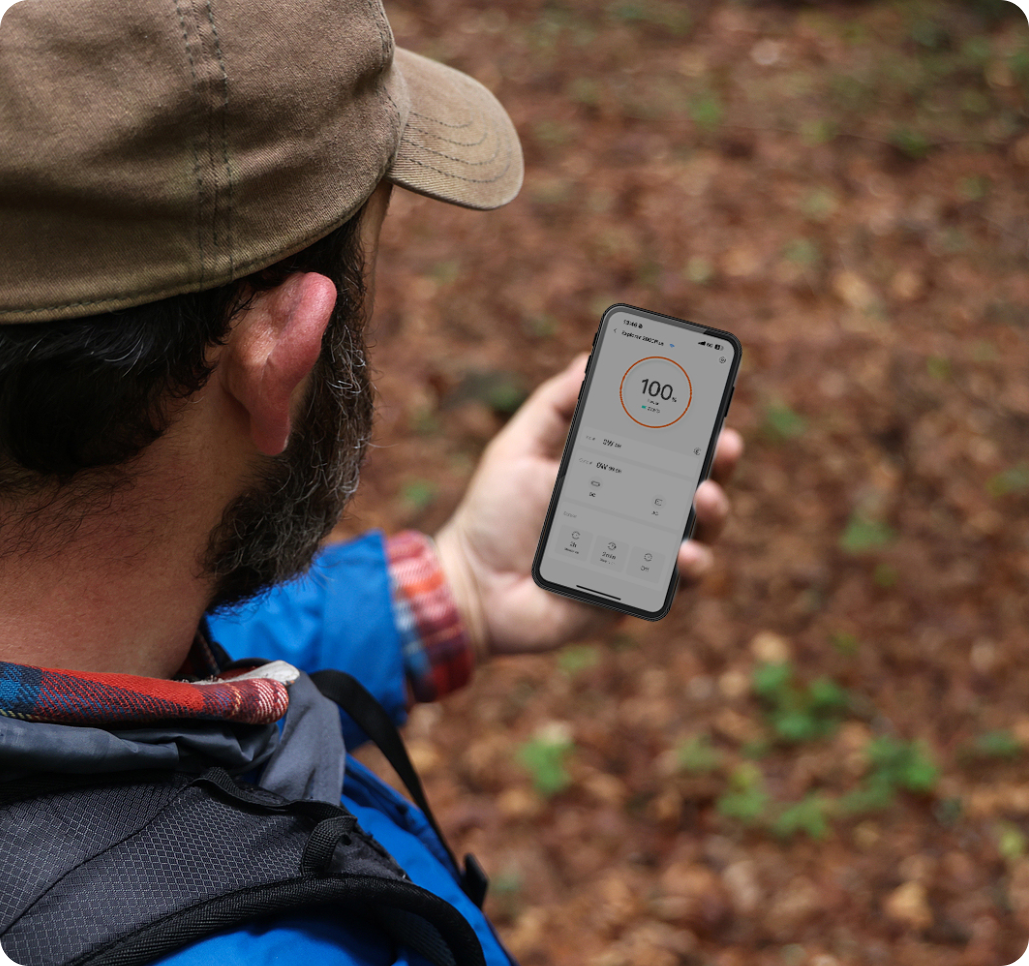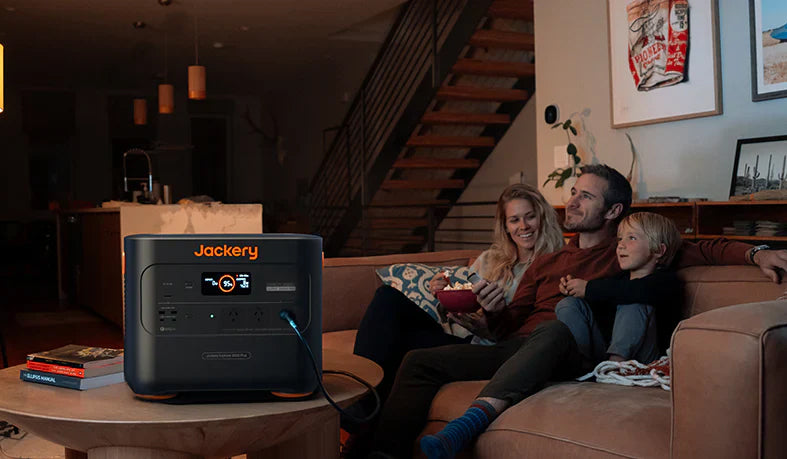|
Key Takeaways: |
|
- A solar battery costs $990 per kilowatt-hour, including the hybrid inverter connected to the solar system. - Understanding solar battery costs is vital for determining the financial viability of your investment. Depending on the brand, prices, including installation, range from $6,000 to $12,000. - The cost of a 6kW solar battery varies based on manufacturer, technology, and capacity. - A 6kW solar battery typically has an ROI of 5-10 years or greater. - We highly recommend Jackery Explorer 2000 Plus, as the portable solar power solution with expandable capacity to satisfy all your power needs with reasonable costs. |
Basics of 6kW Solar Battery
A solar battery is an energy storage technology that stores excess energy solar panels produce. This stored energy can power homes and businesses and be used for other uses during low-light or nighttime hours. Solar batteries provide backup power during outages and reduce reliance on the grid, making them a dependable and sustainable energy alternative.
Solar batteries can also help to cut energy costs by storing excess energy for later use. Instead of feeding excess energy back into the system, you can store it and use it when your solar panels aren't producing electricity. This not only improves the efficiency of your solar power system but also assures a consistent power supply during peak hours or unexpected outages.
How Does a 6kW Solar Battery Work?
A 6kW solar battery is designed to work with a 6kW solar panel installation. During the day, your solar panels create power, and any excess energy not utilised immediately is stored in the solar battery. This stored energy can then be used to power your home or company during low-light or nighttime hours, maintaining a steady source of electricity.
A 6kW solar battery is typically connected to a hybrid inverter, which converts the DC electricity generated by the solar panels into AC power suitable for usage in your house or company. This arrangement enables efficient energy management and utilisation.
Furthermore, a 6kW solar battery can be set to charge from the grid during off-peak hours when electricity prices are lower. This allows you to store cheaper electricity and use it during peak hours when higher rates significantly lower your energy expenditures. Furthermore, this configuration provides a dependable backup power supply during outages, ensuring your critical appliances and systems function.
Aside from the practical benefits of backup power and cost savings, a 6kW solar battery helps to reduce greenhouse gas emissions and reliance on fossil fuels. By storing and utilising excess energy generated by your solar panels, you reduce the demand for electricity from power plants, helping to fight climate change.

How Many Solar Panels Are Needed for a 6kW Solar System?
That will be determined by the size (output) of the solar panels installed. For example, if 415-watt panels are used, a 6kW solar system will have 15 modules, slightly more than 6kW—or 16 for a 6.6kW array.
How Much Roof Space Is Required for a 6kW Solar System?
A 6kW solar power system installation will require approximately 30 square metres of acceptable rooftop space based on a panel size of around 1.8 metres by 1.1 metres. Here's an estimate of how much room 6kW takes up based on 415-watt panels.
How Much Electricity Generated from 6kW Solar System?
Installation location, solar panel orientation, and component quality are all crucial considerations. Still, a 6kW PV system should provide roughly 24 kilowatt-hours of electricity daily, more than the average Australian household consumes daily.
Remember that you will be paid a feed-in tariff for any excess electricity you generate. Furthermore, it is large enough to typically eliminate grid electricity demand on bright days from before midmorning to after midafternoon for ordinary households. Self-consumption is critical for getting the most out of a large system.
6kW Solar Battery Cost
If you use a lot of energy, installing a 6kW solar system with battery backup will help you save money on your electricity costs. Because a 6kW solar battery system generates approximately 24 kWh per day, you can store some of that electricity in a battery system for use at night when the solar panels are inactive or on overcast days when your PV system produces little energy.
Typically, the cost includes solar panels, inverters, installation, and battery storage systems. Prices may also vary depending on the quality of the equipment, the brand, and the additional services provided by the installation company. Getting prices from respected suppliers and installation providers is generally a good idea. Government rebates and incentives can also influence starting prices.
Cost Breakdown of 6kW Solar Battery
Installing a quality 6kW solar system costs an average of $7,387. The cost ranges from $7,028 to $7,666, including the Australian government's solar incentive. The system's gross price is around $9,342.
The system's actual cost varies depending on your STC zone in Australia. STC zones are typically divided into four categories based on the amount of sunshine received in each zone. Areas with the highest solar radiation have a higher STC rating, which means they earn a larger rebate.
The cost of a solar battery is often expressed in dollars per kilowatt hour. It usually costs between $900 and $2,000 per kilowatt hour. The cost of a 10.2kWh solar battery plus a 6.64kWh solar system is around $12,888.
A solar battery alone costs $990 per kilowatt-hour, which includes the hybrid inverter required to connect the battery to the solar system. The 13.5kWh Tesla Powerwall battery with a built-in inverter costs $1200 per kilowatt-hour. Meanwhile, the Sungrow 9.6kWh solar battery costs $1227 per kilowatt-hour and includes a 5kW hybrid inverter.
Several factors influence battery pricing, which we will discuss later. A 6kW solar panel installation includes a 16.6kWh battery. This combined system's installation costs range from around $19,935 at the low end to an average of $25,235. The system's type and quality determine the particular pricing.
Here's a table showing how much a 6kW solar system costs in various STC zones in Australia.
|
STC Zone |
City |
Cost (w/out Rebate) |
Cost (after Rebate) |
|
1 |
Townsville |
$9,342 |
$7,028 |
|
2 |
Alice Springs |
$9,342 |
$7,148 |
|
3 |
Adelaide |
$9,342 |
$7,387 |
|
4 |
Melbourne |
$9,342 |
$7,666 |
6kW Solar Battery Cost Breakdown in Adelaide
The 6kW solar battery cost includes the battery itself, which varies based on manufacturer, technology, and capacity. Labour costs vary according to system complexity and installer rates, making installation costs another critical consideration. Additional Equipment: If your current solar system is incompatible with the battery, you may need an inverter.
|
Component |
Average Cost |
|
Battery Unit |
$6,000-12,000 |
|
Installation Fees |
$1,500-3,000 |
|
Inverter (If Needed) |
$1,500-2,500 |
State Breakdown of Average Solar Installation Costs
The following are the typical retail costs for residential consumers in Australia as of February 2025. The price includes the STC upfront savings and GST. It does not include state rebates or incentives. The given prices are for typical system installations. Premium solar panels and inverters may increase by 20-30% rise.
|
State |
4kW |
5kW |
6kW |
|
VIC |
$4,290 |
$4,860 |
$5,260 |
|
NSW |
$4,160 |
$4,750 |
$4,960 |
|
ACT |
$4,450 |
$4,880 |
$5,510 |
|
QLD |
$4,310 |
$4,640 |
$5,070 |
|
SA |
$4,140 |
$4,800 |
$5,460 |
|
WA |
$3,890 |
$4,210 |
$5,360 |
|
TAS |
$5,160 |
$5,760 |
$6,250 |
|
NT |
$6,780 |
$7,760 |
$9,320 |
|
All |
$4,650 |
$5,210 |
$5,900 |
(Data Source: Solar Choice)
Factors Affect the 6kW Solar Battery Cost
Solar batteries, in particular, can significantly increase the value of a home solar system by providing resilience against grid outages. Because there are multiple alternatives today, the cost of 6kW solar batteries can vary greatly. As a result, it is critical to identify a few key elements that influence solar battery pricing.

Battery Capacity
The cost of a solar battery is mainly determined by its capacity or the total quantity of energy it can store. Home batteries can typically store between 10 and 20 kWh of electricity. The amount of time a solar battery lasts during an outage is determined by various factors, including how much electricity your home draws from it and the size of the solar system linked to it. However, on a basic level, the more battery capacity you have, the longer you will have power during an outage.
If the Battery is DC vs AC
Due to their simplicity, DC batteries are generally less expensive than AC batteries. However, they are far less versatile than AC batteries, and depending on the solar equipment with which the battery is attached, a DC battery may not even be an option.
Balance of System (BOS) Equipment
Installing a solar battery entails more than simply putting it on the wall and connecting it to the main electrical grid. Other essential pieces of equipment are required for house batteries to function properly.
If a Backup Gateway is Required
The backup gateway detects power outages and disconnects the residence from the power grid when one occurs. In this respect, it is similar to a generator transfer switch. This allows the solar battery to provide backup power without feeding power back into the grid.
Critical Loads Panel
The majority of solar batteries can support circuits up to 30 amps. As a result, most battery systems power the circuits that the homeowner values the most rather than the entire house. Even if the battery cannot sustain a central air conditioning unit, it will surely be able to power essentials such as a refrigerator, lighting, outlets for charging portable devices, and so on.
As a result, installing a solar battery usually necessitates installing a sub-panel, often known as a "critical loads panel," which contains the vital circuits that will be backed up in the event of an outage.
Cost of Labor
After investing thousands of dollars in a solar battery, ensuring it is properly installed, has all necessary permits and compliances, and performs as intended for its lifespan is critical. As a result, it's crucial to have the batteries installed by a company with system experience. Anything worth doing should be done right!

Return on Investment with a 6kW Solar Battery
Generally, the ROI for a 6kW solar battery is calculated by factoring in the savings on electricity costs over time. While it is a large upfront expenditure, the savings from lower energy expenses can help to achieve a good ROI.
In Australia, with plenty of sunlight and the possibility of government rebates and feed-in tariffs, the ROI accelerates. It is based on an ideal scenario where most solar energy is used within the home.
The ROI for a 6kW solar battery is typically 5 to 10 years or more. The original installation cost, the amount of energy utilised and stored, the price of grid electricity, and any relevant financial incentives all impact this period.
Furthermore, the ROI is influenced by the battery's ability to hold excess energy at peak generation times, such as daylight hours. Individual energy use trends and local electricity rates must be considered to calculate the ROI accurately.
Solar battery prices vary widely. The brand, model, and size are all elements that will influence the eventual cost of the system. When you install your battery, it will significantly impact the price of the system. Installing a battery along with your solar system will drastically cut total costs. A modified battery, on the other hand, could cost $1,000 or more to install. In Australia, battery storage costs typically range between $1,000 and $1,300 per kWh.
Let's examine the cost of a battery in Australia. The prices listed below include STC discounts and GST but not state incentives. They are for fully installed units.
|
Battery Size |
Battery |
Retrofitted Battery |
|
3kWh |
$3,930 |
$4,650 |
|
8kWh |
$9,600 |
$10,800 |
|
13kWh |
$16,120 |
$18,070 |
|
18kWh |
$23,760 |
$26,280 |
Alternative Option: Jackery Explorer 2000 Plus
Generally, a portable power station, like Jackery Portable Power Station, has a lower initial purchase price than a whole solar battery system, including the battery itself, an inverter, potentially a charge controller, and installation costs. However, a solar battery system involves a significant investment, especially for a system large enough to provide substantial backup power or off-grid capabilities for a home.
Furthermore, portable power stations are typically plug-and-play devices. If you buy them separately, you charge them from a wall outlet (or solar panels) and then plug them into your devices. No complex wiring or professional installation is required. Solar battery systems require professional installation, integration with your existing electrical system, and understanding how the system operates (e.g., setting charge/discharge rates and monitoring performance).
Portable power stations are designed to be moved easily. You can use them indoors during a power outage, camping, in the garden, or even transport them to different locations. So, here we recommend Jackery Explorer 2000 Plus.

Features of Jackery Explorer 2000 Plus
With an expandable capacity from 2 to 12 kWh, the Jackery Explorer 2000 Plus is suitable for multiple uses, such as home backup, outdoor activities and emergencies. It can charge 99% of household appliances and electronics, such as lights, radios, phones, computers, etc. With a 20ms EPS, essential devices such as your refrigerator and blender remain operational instantaneously.
With a 3000W AC output (6000W surge peak), it can power various appliances, from household devices like refrigerators and TVs to power tools, making it suitable for home backup and outdoor use. Recharging Explorer 2000 Plus is easy; it only takes 2.5 hours to fully recharge it, or using wall outlets for 1.7 hours or a carport for 25 hours.
Smart App control via Wi-Fi or Bluetooth allows for remote monitoring, customisation of settings, and access to various charging modes (including a quiet charging mode). It has multiple output ports, including three 230V AC outlets, two USB-A ports, two 100W USB-C ports, and a 12V carport, allowing you to power multiple devices simultaneously.
ChargeShield is Jackery's advanced quick charge technology, featuring 62 protective mechanisms, 12 protective algorithms, and four forms of physical safety protection. Manage and oversee your 2000 Plus with the Jackery App. It accommodates various devices, facilitates real-time status monitoring, and offers customisation options and additional features.
What Can a Jackery Explorer 2000 Plus Run?
The Jackery Explorer 2000 Plus is a powerful portable power station with a 2042.8Wh capacity and a 3000W continuous AC output (6000W surge peak). This substantial power allows it to run various appliances and devices, making it suitable for home backup, outdoor adventures, and professional use.
Home Backup:
Lights: LED bulbs (low wattage) can be used for many hours.
Smartphones and Laptops: Charge multiple times.
Tablets: Charge multiple times.
CPAP Machine: For several nights (depending on wattage).
Full-sized Refrigerator: For a few hours (check the wattage, typically 100-200W running).
Television: For several hours.
Microwave (low wattage): For short cooking times.
Coffee Maker (low wattage): This is for brewing a few pots.
Electric Blanket: This is for many hours on lower settings.
Outdoor Activities:
Portable Fridge/Freezer: For many hours.
Electric Grill (low wattage): For shorter cooking times.
Electric Kettle (low wattage): To boil water a few times.
Induction Cooktop (single burner, low wattage): For limited cooking.
All the devices are listed under "Home Backup."
Projector: For outdoor movie nights.
|
Appliances |
Running Time |
|
Portable AC (1150W) |
1.4-8.3H |
|
Microwave (1000W) |
1.6-9.6H |
|
Kettle (800W) |
2-12H |
|
Coffee Maker (550W) |
2.9-17.5H |
|
Phone (27W) |
60 Times |
(*The working hours are only for reference; the actual working hours depend on your usage.)
How Long Does a 6kW Solar Battery Last?
The lifespan of a 6kW solar battery, which is usually defined in terms of durability and performance, varies depending on several factors. A well-maintained and high-quality 6kW solar battery in Australia can last 10 to 15 years, if not longer.
A battery's longevity is determined by its chemistry, depth of discharge, operating circumstances, maintenance, and general usage patterns. Proper care, adhering to the manufacturer's instructions, and running under appropriate conditions can extend the life of a 6kW solar battery.

What Are the Government Rebates & Incentives Available?
The Australian government offers a variety of discounts and incentives for solar batteries.
Federal: If the Labour government is re-elected, a national battery subsidy will go into effect on July 1, 2025. The proposed Cheaper Home Batteries Programme will provide a $372 subsidy per useable kWh, reducing upfront battery prices by around 30%. Batteries must be VPP-compatible and placed with solar. The plan will be stacked with any state incentives.
Northern Territory: The Home and Business Battery Scheme provides up to $12,000, calculated at $400 per kWh of useful capacity. Only batteries with VPP capability are supported.
New South Wales: Battery buyers in New South Wales can receive approximately $150 per kWh under the Peak Demand Reduction Scheme, with additional compensation for joining a VPP.
Western Australia: The WA Battery Rebate is worth up to $7,500 for Horizon Power customers and $5,000 for Synergy customers, depending on system size. Qualified households can also receive a zero-interest loan of up to $10,000.
South Australia: The Home Battery Scheme provides a significant incentive for installing a solar battery system. Eligible households can receive up to $2,000 in subsidies, lowering the initial cost of a solar battery.
Must be a South Australian resident.
Up to $200 per kWh, maximum at $2,000.
Through approved providers.
These refunds can be combined with government incentives and financing choices.
6kW Solar Battery Cost FAQs
The following are the frequently asked questions about the 6kW solar battery cost.
1. How much does a battery cost for a 6kw solar system?
Australia should expect more significant solar panel battery storage adoption in the coming years as prices continue to fall. Do not be surprised if you see shorter payback periods, increasing market competition, and an increase in solar battery storage installers. Let's look at what you may expect to pay for Domestic and Commercial Solar Battery Storage if you're considering buying a solar battery.
|
Battery Size |
Solar Battery Price |
|
4kWh Solar Battery |
$4,960 |
|
5kWh Solar Battery |
$6,200 |
|
6kWh Solar Battery |
$7,440 |
|
7kWh Solar Battery |
$8,680 |
|
8kWh Solar Battery |
$9,920 |
|
9kWh Solar Battery |
$11,160 |
|
10kWh Solar Battery |
$12,400 |
2. How much do solar batteries cost in Australia?
Solar batteries in Australia cost between $1,500 and $3,000 per kWh. Pricing is determined by storage capacity, location, and additional features such as blackout protection. Daily energy demand and power rates determine the financial return on a solar battery.
3. How much does a 10kW battery cost in Australia?
A 10kW (or, more specifically, 10kWh) solar battery can cost between $8,000 and $12,000, including installation. The cost may vary depending on the battery chemistry (such as lithium-ion), brand (e.g., Tesla Powerwall, Sungrow, BYD), and features such as backup capability.
4. How much is a 5kW solar battery?
A 5kW solar battery storage system typically costs between £9,000 and £10,000. Installation costs vary depending on the size of the battery and whether it is connected to direct current (DC) or alternating current (AC).
5. How many batteries does a 6kW system take?
To power a 6kW solar system, you'll need 24 lead-acid batteries (12V and 200Ah each) or six lithium batteries (400Ah each). A 6kW solar array can power most household appliances, including microwaves, air conditioners, and refrigerators.
Final Thoughts
A 6kW solar battery is appropriate for ordinary households, offering a reasonable mix of price and performance. Prices vary by type from $6,000 to $12,000 plus installation, and understanding solar battery costs is critical for determining the financial sustainability of your purchase. Incentives can help you save up to $2,000. Adding a battery to an existing system is simple and improves efficiency.

